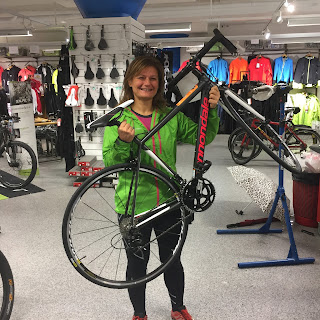Or was it Beijing? At least it feels like that in Bergen right now! "Everybody" is preparing for the Bergen - Voss race, and they are all so fast...
I cannot make up my mind about whether or not I like biking as a training form. I remember when reading Haruki Murakami's book about running how much I agreed with him about the drawbacks of biking: your speed does not depend only on your strength and endurance, like in running. It depends on so many other things, like having a good and light bike, not being afraid of speed, whether you are good in maneuvering around all sorts of obstacles like people, kids, animals, and vehicles on your way... and the 9 million other bikers...
After experimenting a bit with triathlon, I was quite demotivated by the slowness of my heavy hybrid bike. So in winter Frank and I bought racing bikes. And the difference is indeed amazing. But it took me some time to get to the point where I could actually experience the difference. First I had to get past the obstacle of click pedals...
I knew that I would struggle with biking when the feet are locked to the pedals. I had tried this once a couple of years ago, fallen badly, and given it up. But now there was no way around it. During the winter, I put my bike on a stationary roller, and used it for restitution as often as I could. At the same time, I clicked my shoes on and off the pedals a million times to let it become natural. When the spring came, though, and we went for our first biking session outdoors, things did not work as easily as I hoped for. Just at the parking lot, before we even started, I fell twice trying to mount on the bike, and Frank and I were both wondering whether we would at all be biking that day. The thing is, unfortunately, it takes some falling before the brain realizes that it should very quickly unlock the correct foot before trying to set it on the ground. There is no help in soundly standing still with one foot on the ground, if you suddenly want to put also the other foot on the ground forgetting that it is still locked to the pedal.
Of course things depend on earlier experiences. Although I could bike as a kid, it was never a natural part of my daily life. Growing up in a big city, we would take the bikes with us to a park and bike there. In contrast, Frank was biking daily as a kid, even participating in some small competitions. Even though I have biked more than him as an adult, his balance and confidence that comes from childhood is incomparable to mine. For him lock pedals were not a problem at all. After a couple of biking sessions, I was still feeling pretty insecure, and started to discuss whether I should go for another brand of lock pedals that some said were easier to click in and out of. I discussed the matter with Knut Bøe, the legendary biker who now owns the bike shop we bought our bikes from (in fact I've discussed so many things with Knut, and we have been in the shop for advice and help so many times; he is an extremely inspiring and motivating person!), and concluded that I simply needed more practice.
So here I am now. Lock pedals are working fine; it has become natural to click in and out of them without thinking. Back/shoulder/butt aches from long rides are getting less and less painful, and more bearable. I still don't have the level of balance I would have liked. For example, slowing down during a race to get a bottle of drink offered and actually drinking and eating while riding still seem like distant dreams. But as long as I have things to work on and improve, I am somewhat motivated.
The problem is... I simply don't enjoy it that much. Oh, so there I've said it. Biking works perfect as recreation and restitution. But it is a pretty inefficient way of training to improve form. You need so many more hours than for running, you need free passage, empty roads, no people, no cars, and most importantly no other bikers. At least I do. I am so cautious that I slow down for people, cars, and especially unpredictable obstacles like kids and animals. But most other (faster) bikers don't. So there I am, slowing down in wait of an opening, and suddenly comes a fast biker and passes me and takes my opening before my path is again clogged with people. I know many of my friends won't like me saying this, but what I find among the biggest obstacles in improving my biking skills and increasing my enjoyment, are some of the fastest bikers out there.Early Sunday mornings work fine. Before everybody else is out. Say from 8-11, you can get a lot of km done in peace and quiet, with as much speed as you dare. But here is only one Sunday a week... And I seem to be mostly motivated for this kind of commitment when I have an injury or pain that prevents me from running.
Oh well, we'll all see how it goes. It took me years to start enjoying running, so perhaps time is all that it takes. Once (if ever!) I have better balance and speed, and can join the group rides of Fjellgeitene, I am sure it can become much more fun.
And I am going to their after-party of the Bergen-Voss race!! :-D













